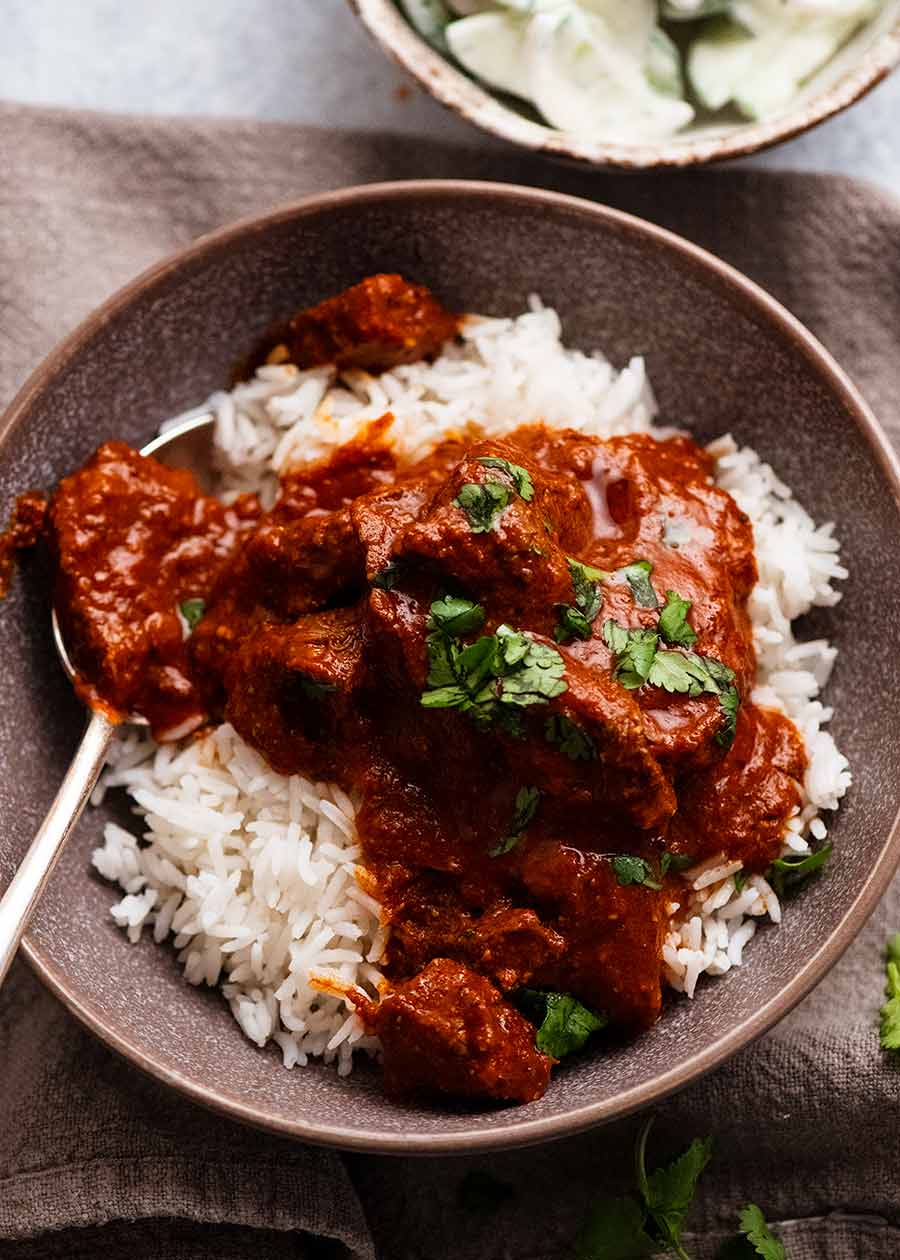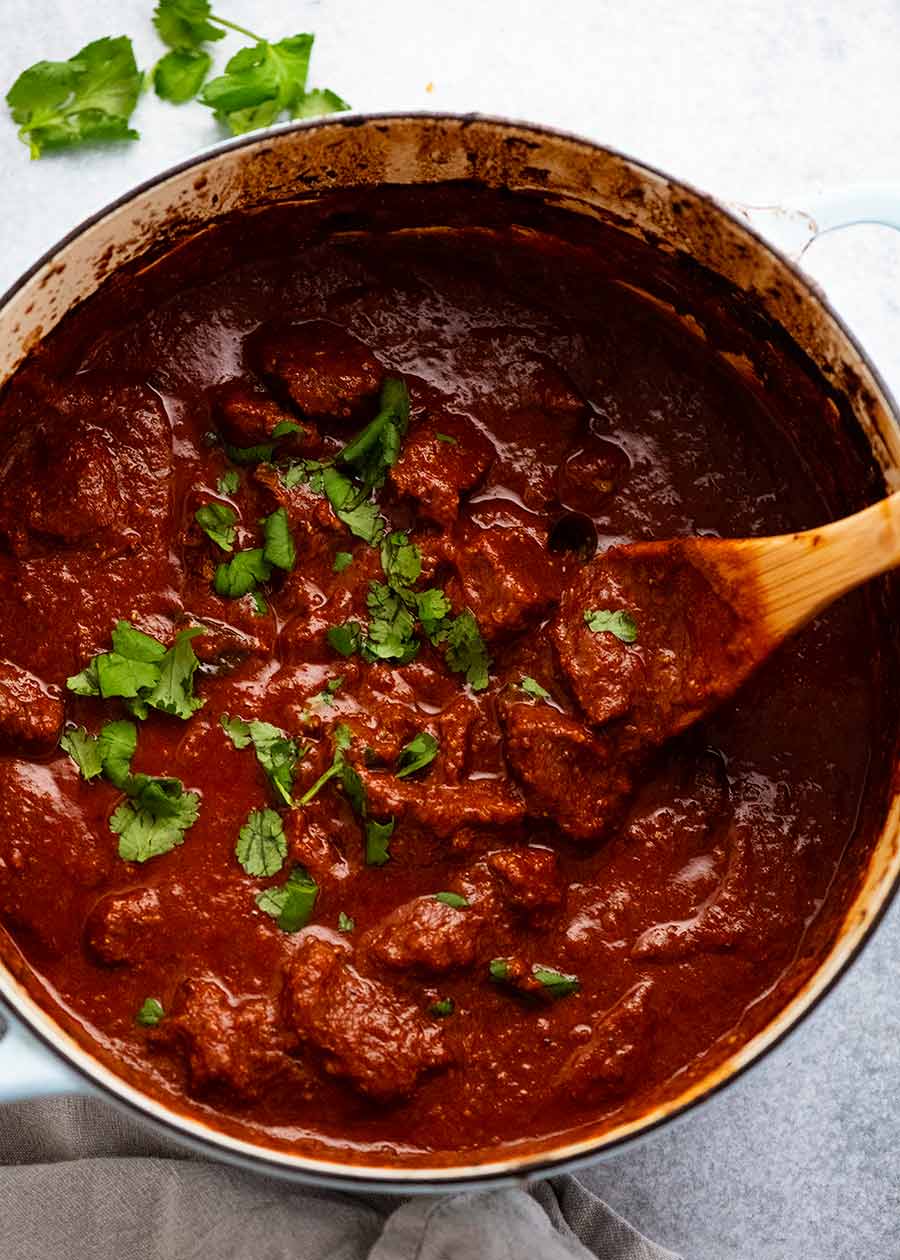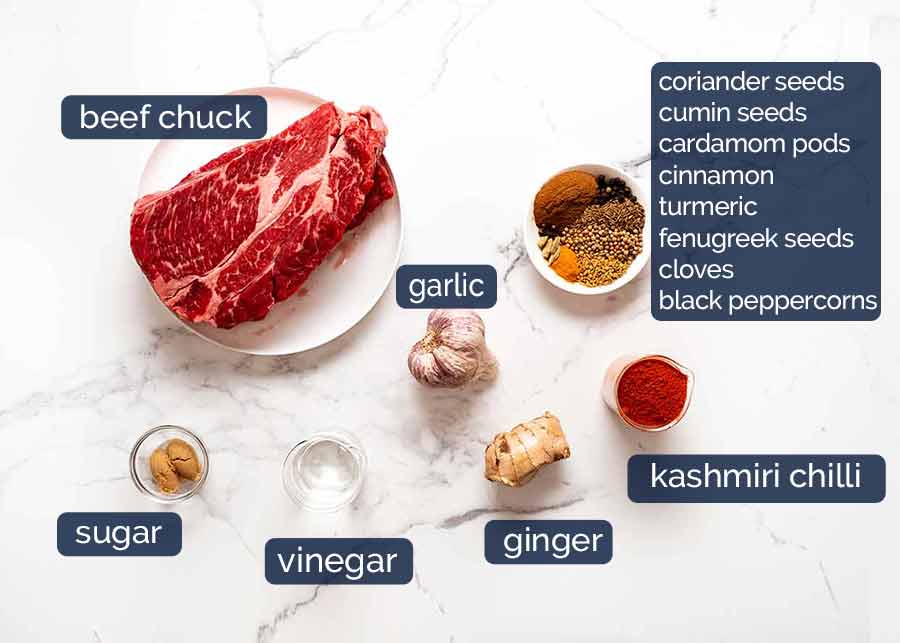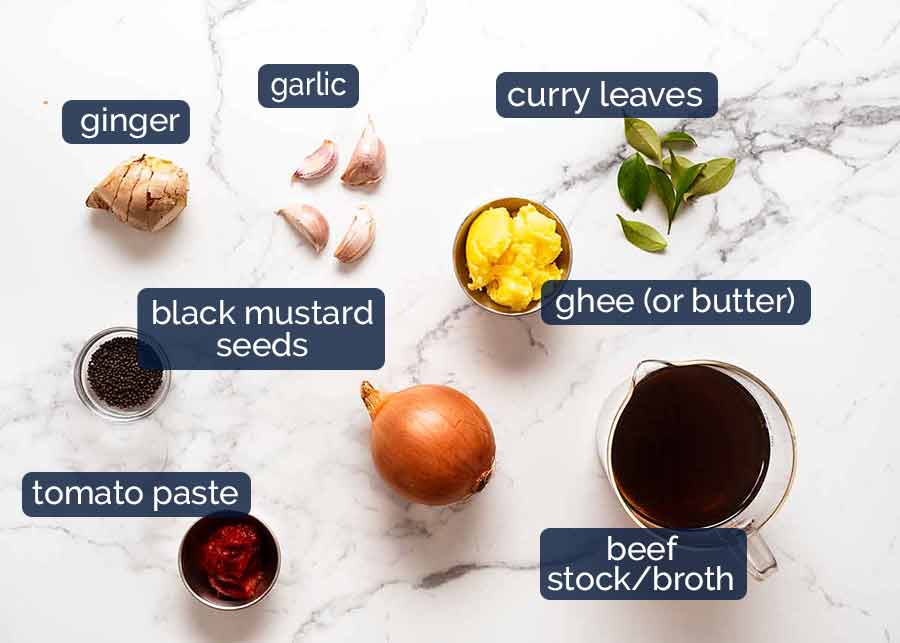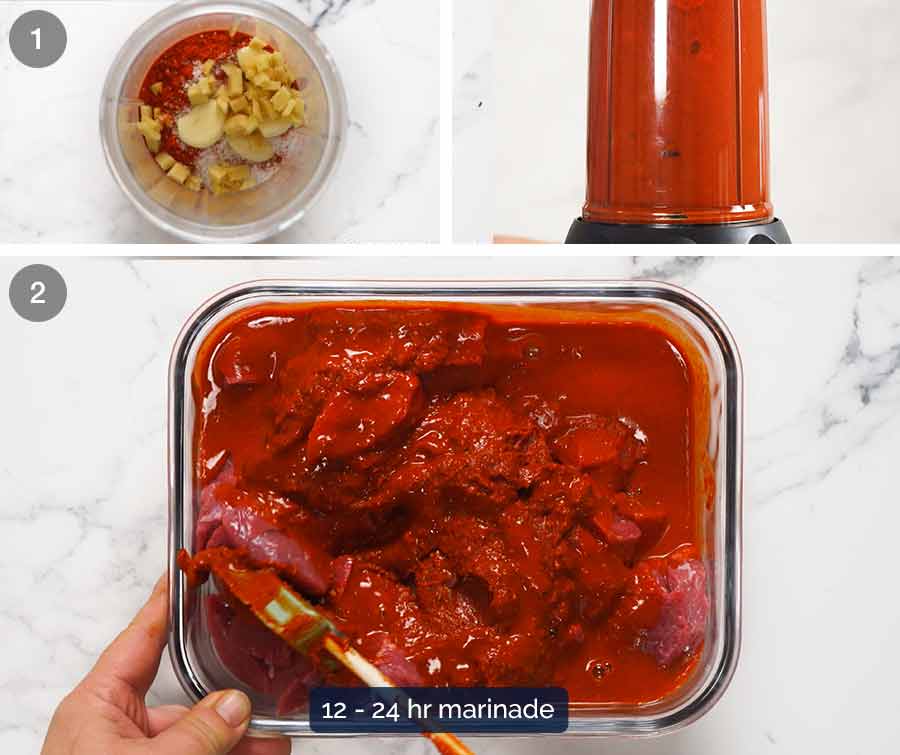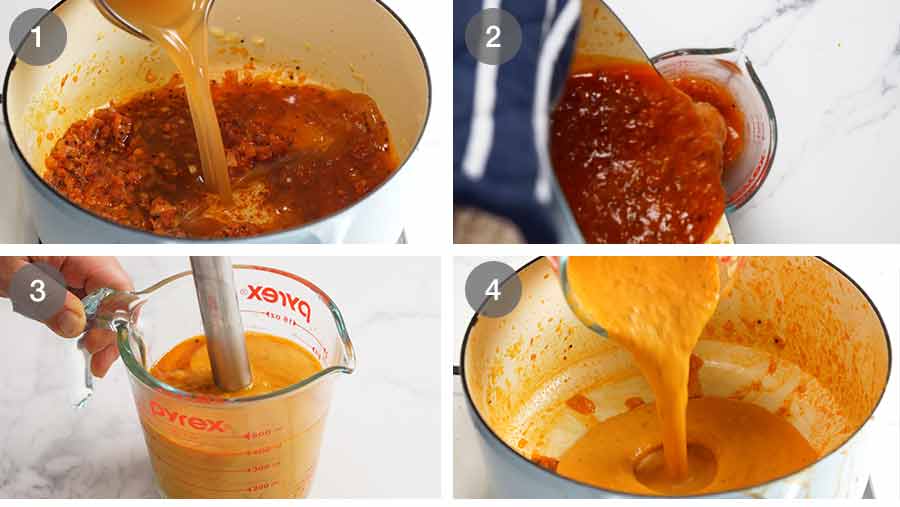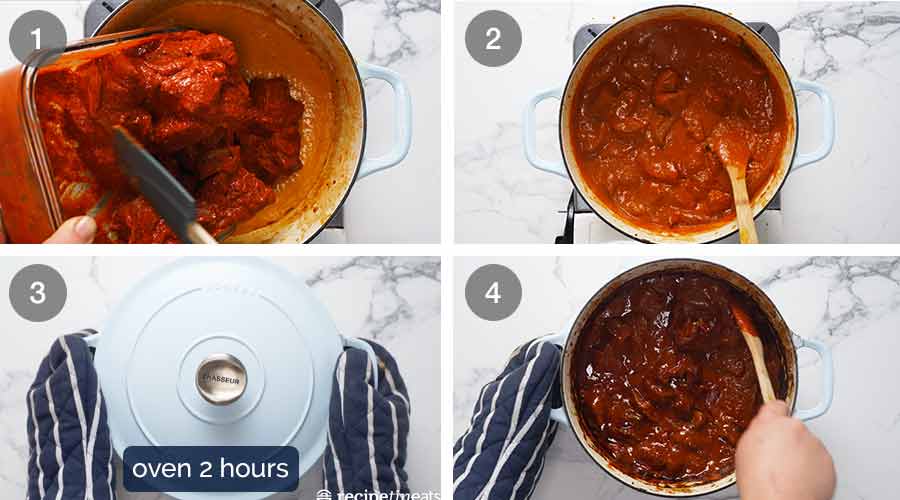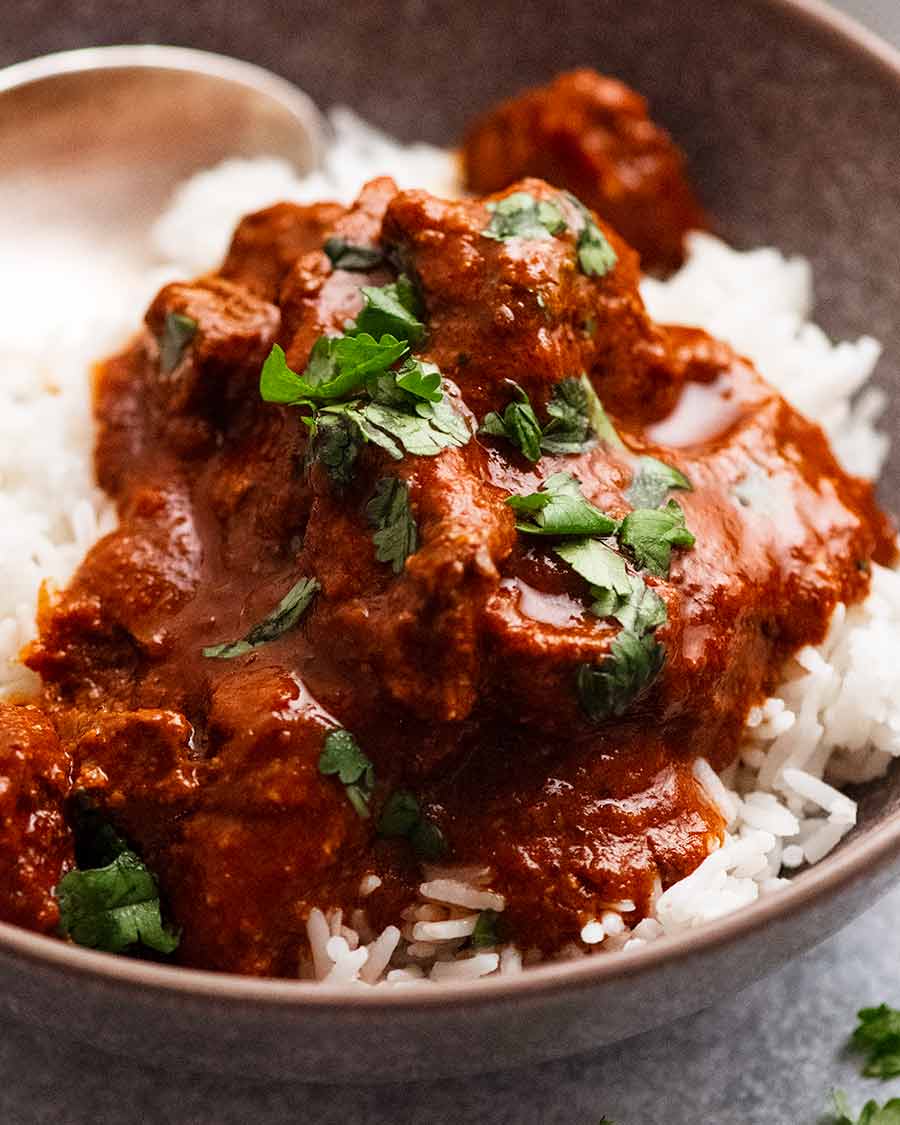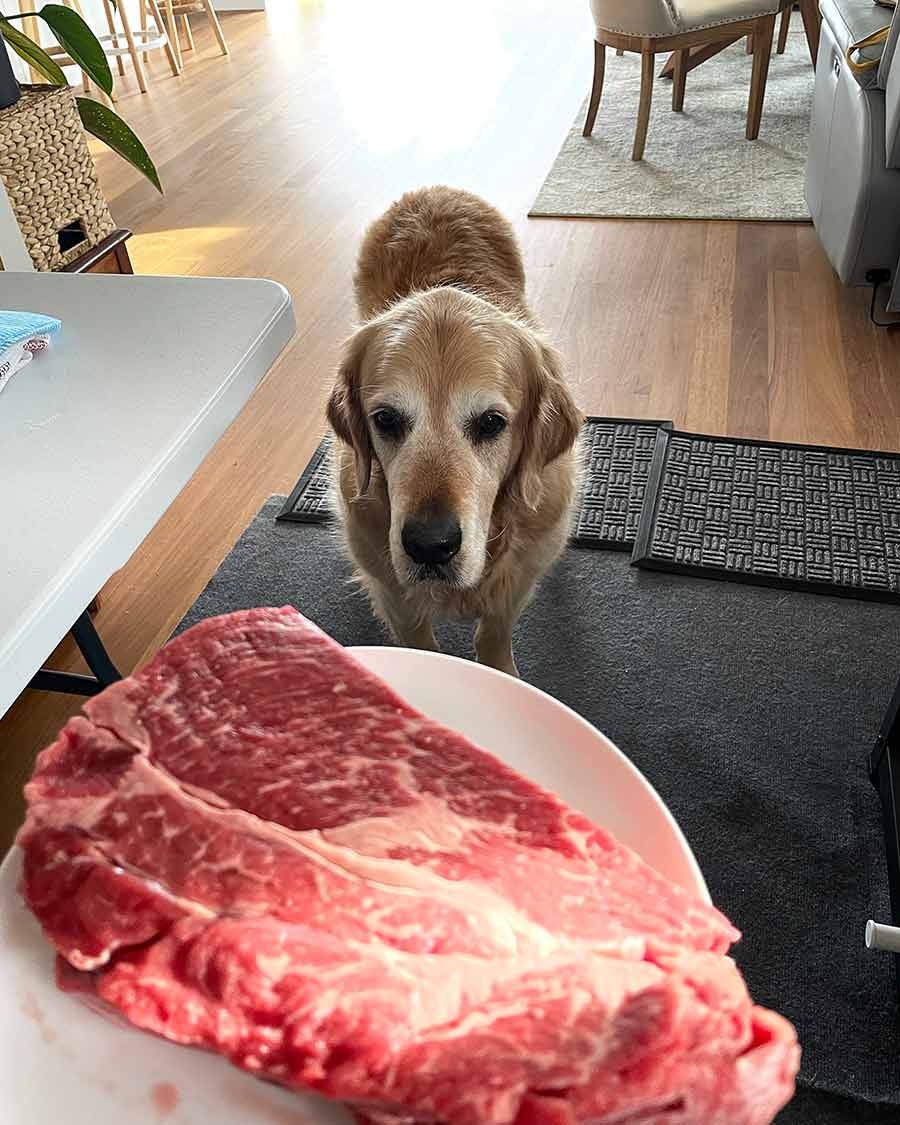Serve with naan for mopping and yogurt to cool that fire.
Vindaloo Beef Curry
Vindaloo is a traditional tomato-based curry gifted to the world from Goa, a sunny pocket of paradise on the Western coast of India. The origins of Vindaloo can be traced back to the time when Portugal ruled Goa in the sixteenth century. In fact, the name Vindaloo comes from carne de vinha d’alhos, a Portuguese dish of pork, wine, and garlic. Local chefs added a stack of spices, switched the wine for vinegar, and that’s how Vindaloo as we know it today came about (in a nutshell!) A staple of Indian restaurant menus around the world, this curry is one for spicy food lovers!! 🌶 Vindaloo is loved for its fiery heat and intense sauce, which packs a generous combination of spices and is sharpened with a good whack of vinegar. It can be made with most proteins, including lamb, goat, pork, prawns, chicken and you could even do a vegetarian number. While pork is actually traditional, here in Australia beef is the most popular version in Indian restaurants so that’s what I’m sharing today. Chunks of meat are slow-cooked for two hours in the Vindaloo sauce until it’s so tender it easily yields to the touch of a spoon!
What does Vindaloo taste like?
Unlike the easygoing and luscious Butter Chicken and Tikka Masala, Vindaloo is a swinging punch to the head! Plenty of Kashmiri chilli powder – a key spice in Vindaloo – brings flavour, heat and the famously rich red colour to the curry. There’s also warm spices in the form of cumin, coriander, cardamom, a little cinnamon and a few others. Finally, a distinct tang from vinegar is a signature Vindaloo flavour that balances the curry and gives it backbone. It’s strong, hot and intense! If you’re wondering how spicy it actually is, I’d say it’s an 7 out of 10. Those who are accustomed to spicy food will no doubt scoff this down without breaking a sweat. I may talk a big chilli-heat game but I can’t actually handle very spicy food, and I don’t find this Vindaloo brutally hot. So for you spice-wimps out there? Don’t worry, see the recipe notes for how to lower the Scoville units in this dish! 😂
Ingredients in Vindaloo
Let’s go through what you need to make this amazing curry! First, the Vindaloo curry paste which is used to marinate the beef and help form the sauce. (Other proteins are covered in the recipe notes.)
1. The beef and the curry paste marinade
Spices – Most of these spices are fairly accessible these days in the spice section of large grocery stores in Australia. The two exceptions are Kashmiri chilli and fenugreek seeds – see next points;Kashmiri chilli – This is an Indian chilli that is a little smoky as well as spicy. The Kashmiri chilli gives the curry sauce its signature bright red colour and chilli heat.Find at: Indian* and some Asian grocery stores (some have Indian sections). Believe it or not, it’s also sold at some Coles grocery stores (Indian section).Also used in: Goan Fish Curry, Tandoori Chicken.Best substitute: It’s a key ingredient (we use 6 tablespoons!) so I really urge you to make the effort to find it. But if you can’t and you’re desperate to try this dish (I don’t blame you!), substitute with a mix of sweet paprika + smoked paprika + chilli powder (pure chilli powder, not US Chili Powder which is a blend) / cayenne pepper.Fenugreek seeds – Another Indian specific cooking spice that actually kind of smells like maple syrup, though doesn’t taste like it when raw.Find it at some Harris Farms, or Indian* and some Asian grocery stores (some have Indian sections). Use leftover for Palak Paneer!Can’t find it? Just leave it out. Beef chuck– An economical cut of beef that is best slow cooked until tender. Try to get it in a block piece so you can cut the pieces yourself. Most butchers and grocery stores cut it too small so the pieces cook too quickly, before the sauce develops enough flavour.Alternative beef: Boneless ribs will also work as would beef osso bucco (use 1.2kg / 2.4lb including bone, keep them whole, the meat will fall off in pieces once slow cooked). If you can get well marbled brisket, that will also work but I find a brisket a bit stringy cooked in stew-like form.Other proteins – Slow cooking cuts of lamb (mutton), goat and pork. Chicken will work too but the cook time needs to be shortened. See recipe notes;Sugar – Just a touch to balance out the vinegar; andGarlic and ginger – Fresh, just roughly chopped because it’s blitzed up with the spices to make the curry paste.
- I go to the Indian Emporium in Dee Why, Sydney. Find at: Indian* and some Asian grocery stores (some have Indian sections). Believe it or not, it’s also sold at some Coles grocery stores (Indian section). Also used in: Goan Fish Curry, Tandoori Chicken. Best substitute: It’s a key ingredient (we use 6 tablespoons!) so I really urge you to make the effort to find it. But if you can’t and you’re desperate to try this dish (I don’t blame you!), substitute with a mix of sweet paprika + smoked paprika + chilli powder (pure chilli powder, not US Chili Powder which is a blend) / cayenne pepper. Find it at some Harris Farms, or Indian* and some Asian grocery stores (some have Indian sections). Use leftover for Palak Paneer! Can’t find it? Just leave it out. Alternative beef: Boneless ribs will also work as would beef osso bucco (use 1.2kg / 2.4lb including bone, keep them whole, the meat will fall off in pieces once slow cooked). If you can get well marbled brisket, that will also work but I find a brisket a bit stringy cooked in stew-like form. Other proteins – Slow cooking cuts of lamb (mutton), goat and pork. Chicken will work too but the cook time needs to be shortened. See recipe notes;
2. Other ingredients in the Vindaloo Sauce
Much of the curry flavour of the Vindaloo Sauce comes from the Vindaloo Curry Paste (above) used to marinade the beef. But there’s a few extra ingredients we use to pep up the base of the sauce flavour:
Beef stock – Stock or broth rather than water to add greater depth of flavour into the Vindaloo curry sauce. I did try with just water, but found the sauce a bit lacking. Ordinarily I’m an advocate of using the best quality beef stock within your budget because producers are yet to successfully mass-produce cheap beef stock to a decent level of quality. However in this case, average store bought beef stock or broth is fine because by the spices are the dominant flavour here! But you get bonus points if you use homemade beef stock. I use homemade when I’m making to impress. 😇Curry leaves – It smells like curry powder, but in fresh curry leaf form! (Though just so you know, curry powder isn’t derived from curry leaves 🙂) Curry leaves add incredible curry perfume into anything it’s used in in a way that can’t be replicated with powders. Fairly accessible nowadays for Sydney-siders, sold at Harris Farms, most Coles and Woolworths. I have a plant! Store leftovers in the fridge (several weeks) or freeze for months.Also used in: Eggplant Curry, Dal, Vegetable Samosa Pie, Cabbage Thoran. Throw in 10 or so when cooking Curried Rice, or into this Indian Chickpea Curry or Vegetable Curry – it will really take it to a new level! Substitute: dried curry leaves (not quite the same, but it’s the best sub) or Garam Masala powder;Ghee (or butter) – The fat used in Indian cooking which adds an intense buttery flavour. Ghee is basically the same thing as clarified butter. This is simply normal butter but with milk solids and water removed, leaving behind pure butter fat. You can either make your own Ghee (it’s cheaper, really easy and keeps for months), buy it, or just use normal butter;Black mustard seeds – they look like poppyseeds but have a slight wasabi-like bite to them. And they smell Indian, not Japanese! Not spicy, more a fresh zing. It’s about $1.50 in small packs at Indian grocery stores – I go to Indian Emporium in Dee Why on the Northern Beaches, Sydney. Also sold in the Indian food section at some Woolworths (Australia) $1.70, and online – small, light pack so postage should be minimal! Also used in: Eggplant Curry, Dal, Vegetable Samosa Pie, Cabbage Thoran; andGinger and garlic – It’s rare to see an Indian recipe that don’t include these, and Vindaloo is no exception!
How to make Vindaloo Curry
Vindaloo starts with a curry paste made by blitzing or grinding a generous amount of chilli and spices, fresh garlic and ginger. This is then used to marinate beef before before slow cooking in a sauce until the meat is fall-apart-tender. Ordinarily I’m an advocate of using the best quality beef stock within your budget because producers are yet to successfully mass-produce cheap beef stock to a decent level of quality. However in this case, average store bought beef stock or broth is fine because by the spices are the dominant flavour here! But you get bonus points if you use homemade beef stock. I use homemade when I’m making to impress. 😇 Store leftovers in the fridge (several weeks) or freeze for months. Also used in: Eggplant Curry, Dal, Vegetable Samosa Pie, Cabbage Thoran. Throw in 10 or so when cooking Curried Rice, or into this Indian Chickpea Curry or Vegetable Curry – it will really take it to a new level! Substitute: dried curry leaves (not quite the same, but it’s the best sub) or Garam Masala powder; You can either make your own Ghee (it’s cheaper, really easy and keeps for months), buy it, or just use normal butter; Also used in: Eggplant Curry, Dal, Vegetable Samosa Pie, Cabbage Thoran; and
1. Vindaloo curry paste beef marinade
2. Making the Vindaloo curry sauce base
3. Slow cook beef until tender
I like to do the slow cooking step in the oven because it’s entirely hands off. No stirring, no need to worry about the base catching. But if can also be done on a very low heat on the stove.
The oven temperature is 190°C/375°F (170°C standard) which sounds higher than you might expect. But this is the temperature that replicates a low heat on the stove. If you take a peek in the pot midway through cooking, you’ll see that the surface of the liquid is barely bubbling – if at all – which is exactly what you want. I use this same temperature for other slow cooked stew-type things such as Beef Bourguignon, Massaman Lamb Shanks. For other dishes, I will cook for longer at a lower heat where they benefit from the longer cook times.
What to serve with Vindaloo curry
Serve over basmati rice which is the traditional rice for Indian food, though any type of plain rice will work fine here (white, jasmine, brown, or low-carb cauliflower rice). Add a dollop of plain yogurt which will cool the spiciness and a sprinkle of coriander/cilantro (for freshness).
Complete your Indian menu!
And if you’re going all out, complete your Indian feast with:
Samosas to start. Golden parcels of crispy pastry filled with spiced potato, this Indian street food is a popular starter in Indian restaurants around the world. This recipe is fun to make and ridiculously good!Parkoras – Another starter option. Vegetable fritters – the Indian way!Homemade Naan (it’s naturally no knead!) – The whole RecipeTin team got involved coming up with what we think is the best possible naan that a home cook can make on the stove, just in case you happen not to have a tandoor sitting in the middle of your kitchen! It’s fluffy with the signature chewiness just like you get at restaurants, and you’d never mistake this for another basic flatbread. No yeast? Make this simple No Yeast Flatbread instead!
Interestingly, Indian food doesn’t have side salads like we do in Western countries. My theory is because vegetarian food is so prevalent in Indian cooking. However, here are some vegetable sides that I think work well with Indian themed menus: So, fellow curry lovers, what do you think of my latest addition to my Indian curry collection?? Will you give it a go? Think you can handle the heat?? 🌶🌶🌶 – Nagi x
Watch how to make it
Life of Dozer
Still waiting for the one in a million moment that a slab of beef hits the floor.
